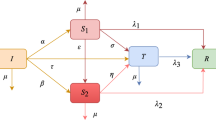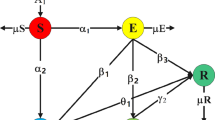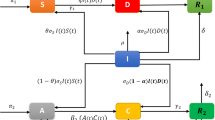Abstract
This paper investigates rumor transmission over online social networks, such as those via Facebook or Twitter, where users liberally generate visible content to their followers, and the attractiveness of rumors varies over time and gives rise to opposition such as counter-rumors. All users in social media platforms are modeled as nodes in one of five compartments of a directed random graph: susceptible, hesitating, infected, mitigated, and recovered (SHIMR). The system is expressed with edge-based formulation and the transition dynamics are derived as a system of ordinary differential equations. We further allow individuals to decide whether to share, or disregard, or debunk the rumor so as to balance the potential gain and loss. This decision process is formulated as a game, and the condition to achieve mixed Nash equilibrium is derived. The system dynamics under equilibrium are solved and verified based on simulation results. A series of parametric analyses are conducted to investigate the factors that affect the transmission process. Insights are drawn from these results to help social media platforms design proper control strategies that can enhance the robustness of the online community against rumors.







Similar content being viewed by others

Explore related subjects
Discover the latest articles and news from researchers in related subjects, suggested using machine learning.Data Availability
All data generated or analysed during this study are included in this published article.
Notes
In this paper, we follow the epidemiology and disease literature (e.g., see Angstmann et al. (2016) and Liu et al. (2019)) and use the word “compartment” to represent the subset of network nodes that are in one of the states. We could have instead used other terminologies (such as “subset”) throughout the paper.
Such a condition may be reasonable if the title of a post in social media does not provides sufficient information on the credibility of its content, or if most accounts have a regular schedule of deleting (or forgetting) dated posts.
References
Albert R, Barabási AL (2002) Statistical mechanics of complex networks. Rev Mod Phys 74(1):47. https://doi.org/10.1103/RevModPhys.74.47
Albert R, Jeong H, Barabási AL (2000) Error and attack tolerance of complex networks. Nature 406(6794):378–382. https://doi.org/10.1038/35019019
Angstmann CN, Henry BI, McGann AV (2016) A fractional-order infectivity SIR model. Phys A 452:86–93. https://doi.org/10.1016/j.physa.2016.02.029
Chen W, Yuan Y, Zhang L (2010) Scalable influence maximization in social networks under the linear threshold model. In: 2010 IEEE International Conference on Data Mining, IEEE, pp 88–97, https://doi.org/10.1109/ICDM.2010.118
Daley DJ, Kendall DG (1964) Epidemics and rumours. Nature 204(4963):1118. https://doi.org/10.1038/2041118a0
Delamater PL, Street EJ, Leslie TF, Yang YT, Jacobsen KH (2019) Complexity of the basic reproduction number (R0). Emerg Infect Dis 25(1):1. https://doi.org/10.3201/eid2501.171901
Diekmann O, Heesterbeek JAP, Metz JA (1990) On the definition and the computation of the basic reproduction ratio (R0) in models for infectious diseases in heterogeneous populations. J Math Biol 28(4):365–382. https://doi.org/10.1007/BF00178324
Etesami SR, Başar T (2016) Complexity of equilibrium in competitive diffusion games on social networks. Automatica 68:100–110. https://doi.org/10.1016/j.automatica.2016.01.063
Fu F, Liu L, Wang L (2008) Empirical analysis of online social networks in the age of web 2.0. Physica A 387(2-3):675–684, https://doi.org/10.1016/j.physa.2007.10.006
Gomez-Rodriguez M, Leskovec J, Schölkopf B (2013) Modeling information propagation with survival theory. International Conference on Machine Learning, PMLR 28:666–674
Guzavicius A, Vilkė R, Barkauskas V (2014) Behavioural finance: Corporate social responsibility approach. Procedia Soc Behav Sci 156:518–523. https://doi.org/10.1016/j.sbspro.2014.11.232
Hale ET, Yin W, Zhang Y (2008) Fixed-point continuation for l1-minimization: Methodology and convergence. SIAM J Optim 19(3):1107–1130. https://doi.org/10.1137/070698920
He Q, Wang X, Yi B, Mao F, Cai Y, Huang M (2019) Opinion maximization through unknown influence power in social networks under weighted voter model. IEEE Syst J 14(2):1874–1885. https://doi.org/10.1109/JSYST.2019.2922373
Hosseini S, Azgomi MA (2018) The dynamics of an SEIRS-QV malware propagation model in heterogeneous networks. Phys A 512:803–817. https://doi.org/10.1016/j.physa.2018.08.081
Howell L (2013) Digital wildfires in a hyperconnected world. WEF report 3(2013):15–94
Huang DW, Yang LX, Li P, Yang X, Tang YY (2020) Developing cost-effective rumor-refuting strategy through game-theoretic approach. IEEE Syst J 15(4):5034–5045. https://doi.org/10.1109/JSYST.2020.3020078
Huang J, Su Q (2013) A rumor spreading model based on user browsing behavior analysis in microblog. In: 2013 10th International Conference on Service Systems and Service Management, IEEE, pp 170–173, https://doi.org/10.1109/ICSSSM.2013.6602630
Huo L, Cheng Y (2019) Dynamical analysis of a IWSR rumor spreading model with considering the self-growth mechanism and indiscernible degree. Phys A 536:120940. https://doi.org/10.1016/j.physa.2019.04.176
Islam MS, Sarkar T, Khan SH, Kamal AHM, Hasan SM, Kabir A, Yeasmin D, Islam MA, Chowdhury KIA, Anwar KS et al (2020) Covid-19-related infodemic and its impact on public health: A global social media analysis. Am J Trop Med Hyg 103(4):1621. https://doi.org/10.4269/ajtmh.20-0812
Kempe D, Kleinberg J, Tardos É (2003) Maximizing the spread of influence through a social network. In: Proceedings of the ninth ACM SIGKDD international conference on Knowledge discovery and data mining, pp 137–146, https://doi.org/10.1145/956750.956769
Kermack WO, McKendrick AG (1927) A contribution to the mathematical theory of epidemics. Proc R Soc Lond A 115(772):700–721. https://doi.org/10.1098/rspa.1927.0118
Khamis S, Ang L, Welling R (2017) Self-branding, ‘micro-celebrity’ and the rise of social media influencers. Celebr Stud 8(2):191–208. https://doi.org/10.1080/19392397.2016.1218292
Knapp RH (1944) A psychology of rumor. Public Opin Q 8(1):22–37. https://doi.org/10.1086/265665
Lee H, Oh HJ (2017) Normative mechanism of rumor dissemination on Twitter. Cyberpsychology Behav Soc Netw 20(3):164–171. https://doi.org/10.1089/cyber.2016.0447
Li M, Liu F (2016) Game theory-based network rumor spreading model. In: 2016 International Conference on Network and Information Systems for Computers (ICNISC), IEEE, pp 89–94, https://doi.org/10.1109/ICNISC.2016.029
Li Y, Ma J, Fang F (2020) How the emotion’s type and intensity affect rumor spreading. arXiv preprint https://doi.org/10.48550/arXiv.2012.08861
Liu W, Wu X, Yang W, Zhu X, Zhong S (2019) Modeling cyber rumor spreading over mobile social networks: A compartment approach. Appl Math Comput 343:214–229. https://doi.org/10.1016/j.amc.2018.09.048
Lu F, Zhang W, Shao L, Jiang X, Xu P, Jin H (2017) Scalable influence maximization under independent cascade model. J Netw Comput Appl 86:15–23. https://doi.org/10.1016/j.jnca.2016.10.020
Lu L, Ouyang Y (2019) Dynamic vaccination game in a heterogeneous mixing population. Phys A 533:122032. https://doi.org/10.1016/j.physa.2019.122032
Lü L, Chen DB, Zhou T (2011) The small world yields the most effective information spreading. New J Phys 13(12):123005. https://doi.org/10.1088/1367-2630/13/12/123005
Maki DP, Thompson M (1973) Mathematical models and applications: with emphasis on the social life, and management sciences. Tech. rep
Mashwama P, Fashoto SG, Mbunge E, Gwebu S (2020) Development of a mobile inter-vehicular communication system based on gossip algorithm. Int J Interact Mob Technol 14(11). https://doi.org/10.3991/ijim.v14i11.12949
McDougall J, Stoner EC (1938) The computation of Fermi-Dirac functions. Proc R Soc Lond A 237(773):67–104. https://doi.org/10.1098/rsta.1938.0004
Miller JC (2011) A note on a paper by Erik Volz: SIR dynamics in random networks. J Math Biol 62(3):349–358. https://doi.org/10.1007/s00285-010-0337-9
Molloy M, Reed B (1995) A critical point for random graphs with a given degree sequence. Random Struct Algorithms 6(2–3):161–180. https://doi.org/10.1002/rsa.3240060204
Muhlmeyer M, Agarwal S, Huang J (2020) Modeling social contagion and information diffusion in complex socio-technical systems. IEEE Syst J 14(4):5187–5198. https://doi.org/10.1109/JSYST.2020.2993542
Nekovee M, Moreno Y, Bianconi G, Marsili M (2007) Theory of rumour spreading in complex social networks. Phys A 374(1):457–470. https://doi.org/10.1016/j.physa.2006.07.017
Newman ME, Strogatz SH, Watts DJ (2001) Random graphs with arbitrary degree distributions and their applications. Phys Rev E 64(2):026118. https://doi.org/10.1103/PhysRevE.64.026118
Pratt JW (1978) Risk aversion in the small and in the large. In: Uncertainty in economics, Elsevier, pp 59–79, https://doi.org/10.1016/B978-0-12-214850-7.50010-3
Qing D, ZhengGong Z (2020) A stochastic game model for analysis of rumor and anti-rumor propagation in social networks. In: 2020 IEEE 6th International Conference on Control Science and Systems Engineering (ICCSSE), IEEE, pp 63–67, https://doi.org/10.1109/ICCSSE50399.2020.9171954
Rey D, Gardner L, Waller ST (2016) Finding outbreak trees in networks with limited information. Netw Spat Econ 16(2):687–721. https://doi.org/10.1007/s11067-015-9294-6
Spencer S, Srikant R (2015) On the impossibility of localizing multiple rumor sources in a line graph. ACM SIGMETRICS Performance Evaluation Review 43(2):66–68. https://doi.org/10.1145/2825236.2825262
Sudbury A (1985) The proportion of the population never hearing a rumour. J Appl Probab 22(2):443–446. https://doi.org/10.2307/3213787
Vega-Oliveros DA, da Fontoura Costa L, Rodrigues FA (2020) Influence maximization by rumor spreading on correlated networks through community identification. Commun Nonlinear Sci Numer Simul 83:105094. https://doi.org/10.1016/j.cnsns.2019.105094
Volz E (2008) SIR dynamics in random networks with heterogeneous connectivity. J Math Biol 56(3):293–310. https://doi.org/10.1007/s00285-007-0116-4
Wang B, Chen G, Fu L, Song L, Wang X (2017) Drimux: Dynamic rumor influence minimization with user experience in social networks. IEEE Trans Knowl Data Eng 29(10):2168–2181. https://doi.org/10.1109/TKDE.2017.2728064
Wang Y, Wu J, Yang WS (2013) Cloud-based multicasting with feedback in mobile social networks. IEEE Trans Wirel Commun 12(12):6043–6053. https://doi.org/10.1109/TWC.2013.102313.121508
Wang Y, Chen X, Li J (2015) A new genetic-based rumor diffusion model for social networks. In: 2015 International Conference on Cyber Security of Smart Cities, Industrial Control System and Communications (SSIC), IEEE, pp 1–5, https://doi.org/10.1109/SSIC.2015.7245327
Xian J, Yang D, Pan L, Liu M (2020) Wang W (2020) Containing rumors spreading on correlated multiplex networks. J Stat Mech-Theory Exp 2:023402. https://doi.org/10.1088/1742-5468/ab6849
Xiang N, Zhou Z, Pan Z (2018) Using SIR model to simulate emotion contagion in dynamic crowd aggregation process. Int J Performability Eng 14(1):134, https://doi.org/10.23940/ijpe.18.01.p14.134143
Xiao Y, Chen D, Wei S, Li Q, Wang H, Xu M (2019) Rumor propagation dynamic model based on evolutionary game and anti-rumor. Nonlinear Dyn 95(1):523–539. https://doi.org/10.1007/s11071-018-4579-1
Yan X, Jiang P (2018) Effect of the dynamics of human behavior on the competitive spreading of information. Comput Hum Behav 89:1–7. https://doi.org/10.1016/j.chb.2018.07.014
Zan Y (2018) DSIR double-rumors spreading model in complex networks. Chaos, Solitons & Fractals 110:191–202. https://doi.org/10.1016/j.chaos.2018.03.021
Zan Y, Wu J, Li P, Yu Q (2014) SICR rumor spreading model in complex networks: Counterattack and self-resistance. Phys A 405:159–170. https://doi.org/10.1016/j.physa.2014.03.021
Zanette DH (2002) Dynamics of rumor propagation on small-world networks. Phys Rev E 65(4):041908. https://doi.org/10.1103/PhysRevE.65.041908
Zhang Y, Su Y, Li W, Liu H (2018) Modeling rumor propagation and refutation with time effect in online social networks. Int J Mod Phys C 29(08):1850068. https://doi.org/10.1142/S0129183118500687
Zhu T, Wang B, Wu B, Zhu C (2014) Maximizing the spread of influence ranking in social networks. Inf Sci 278:535–544. https://doi.org/10.1016/j.ins.2014.03.070
Zhuang YB, Chen J, Li Zh (2017) Modeling the cooperative and competitive contagions in online social networks. Phys A 484:141–151. https://doi.org/10.1016/j.physa.2017.04.129
Zinoviev D, Duong V (2011) A game theoretical approach to broadcast information diffusion in social networks. arXiv preprint arXiv:11065174 https://doi.org/10.48550/arXiv.1106.5174730
Acknowledgements
The authors thank the editor and two anonymous referees for their valuable suggestions. The first author was a visiting doctoral student at Illinois while this research was conducted. The first author also thanks Mr. Ruifeng She (Ph.D. student at Illinois) for his comments and help.
Author information
Authors and Affiliations
Corresponding author
Ethics declarations
Competing Interests
The authors declare that they have no known competing financial interests or personal relationships that could have appeared to influence the work reported in this paper.
Additional information
Publisher’s Note
Springer Nature remains neutral with regard to jurisdictional claims in published maps and institutional affiliations.
Appendix A. Derivation of \(R_e\)
Appendix A. Derivation of \(R_e\)
We follow the idea mentioned in Diekmann et al. (1990) to derive \(R_e(t)\) which the definition can be found in Sect. 3.2. The computation of \(R_e(t)\) requires information only on compartments \(H_{jk}(t)\), \(I_{jk}(t)\) and \(M_{jk}(t)\). For simplicity, we hereon omit the time argument for all variables in this appendix.
Based on Eq. (18), for all \(j \in \{1, ...,J\}, k \in \{1, ...,K\}\), we have
This can be written in the following vector form
where \(\mathcal {F} = [1 \cdot (r_I \frac{\theta _I}{\theta } + r_M \frac{\theta _M}{\theta })S_{11}, \cdots , J(r_I\frac{\theta _I}{\theta } + r_M\frac{\theta _M}{\theta })S_{JK}, \mathbf {0}_{1 \times JK}, \mathbf {0}_{1 \times JK}]^T\) represents the increment of hesitating users from all other compartments, while \(\begin{aligned}&\mathcal {V} = [\beta H_{11}, \cdots , \beta H_{JK}, \mu _{I}I_{11}-\beta \gamma _{11} q H_{11}, \cdots , \mu _{I}I_{JK}-\beta \gamma _{JK}qH_{JK}, \mu _{M}M_{11}-\beta \gamma _{11}(1 - q)H_{11}, \cdots , \mu _{M}M_{JK}-\beta \gamma _{JK}(1 - q)H_{JK}]^T\end{aligned}\) represents the transmission of hesitating users into other compartments. Here \(\mathbf {0}\) represents a zero vector/matrix. The Jacobian matrices of \(\mathcal {F}\) and \(\mathcal {V}\), denoted as F and V, can be computed respectively as follows:
where
In the above, E represents the identity matrix. Following Diekmann et al. (1990), we call \(FV^{-1}\) the next generation matrix for the model, and it can be calculated as:
It is well known from Lyapunov stability theorem that the effective reproduction number \(R_e\) is the spectral radius of matrix \(FV^{-1}\); i.e.:
From Eq. (29), \(FV^{-1}\) is an upper triangular block matrix, whose eigenvalues are given by those of its only nonzero diagonal block submatrix \(-BQ^{-1}PD^{-1}\). Note that
Clearly, rank (\(-BQ^{-1}PD^{-1}\)) = 1. Hence,
Rights and permissions
About this article
Cite this article
Liu, W., Wang, J. & Ouyang, Y. Rumor Transmission in Online Social Networks Under Nash Equilibrium of a Psychological Decision Game. Netw Spat Econ 22, 831–854 (2022). https://doi.org/10.1007/s11067-022-09574-9
Accepted:
Published:
Issue Date:
DOI: https://doi.org/10.1007/s11067-022-09574-9



